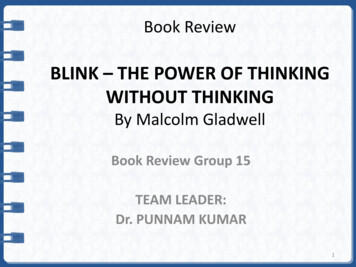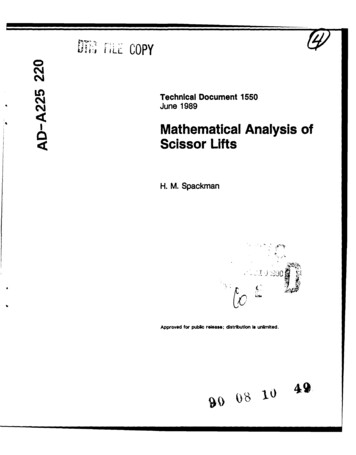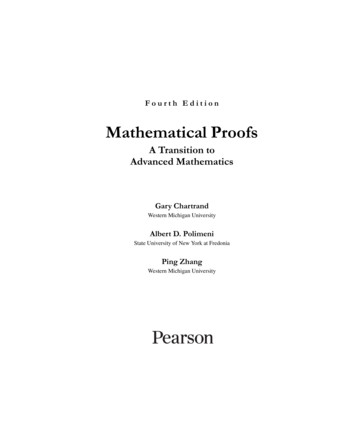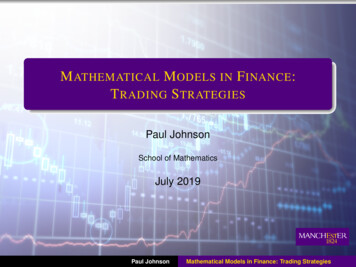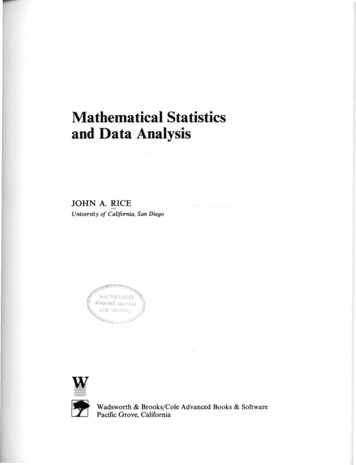
Transcription
Universal Journal of Educational Research 7(1): 1-9, 2019DOI: tigation of the Mathematical Thinking Processes ofStudents in Mathematics Education Supported withGraph TheorySevinç Mert UyangörFaculty of Necatibey Education, Balıkesir University, TurkeyCopyright 2019 by authors, all rights reserved. Authors agree that this article remains permanently open access underthe terms of the Creative Commons Attribution License 4.0 International LicenseAbstractIn the most general sense, mathematicalthinking can be defined as using mathematical techniques,concepts, and methods, directly or indirectly, in theproblem-solving process. In this study, efforts were madeto include the Graph Theory of mathematics, which isfound abundantly in physics, chemistry, computernetworks, economics, administrative science, datacommunication, transportation planning, engineering, andsimilar areas of daily life, into the mathematics instructionprocess. Because suitable problems are selected in graphtheory, the mathematical thinking skills of the students canbe developed. A fundamental, qualitative researchapproach was adopted in this study, in which themathematical thinking processes of 12th-grade studentswere examined. Two girls and two boys with average andhigh mathematics success who were in the 12th grade of apublic school in Balıkesir in the 2018-2019 AcademicSchool year constituted the working group of the research.The data in the study were collected with the twoworksheets the researchers prepared, the clinicalinterviews held during the application, and throughunstructured observations. The results obtained byanalyzing the data in the process of mathematics teaching,in which graph theory included are: When students solvedthe problems they faced and when they ascend top steps ofmathematical thinking, they showed a better performancewhen compared to the other studies. Because, in the stepsof privatization, generalization and assumption, only 1 ofthe total 8 responses given by the students is empty. At thestage of proof which is the final stage of mathematicalthinking, the students have achieved a success rate of 75%despite they did not have a lesson about making proofs.This situation was interpreted as the visual model ofproblems selected from graph theory and attracting theattention of the questions as stated by the students. Theresults of this study show that, in the process ofmathematics teaching, especially if teachers provideenough diversity students by using different fields ofmathematics, they can increase the performances ofstudents in mathematical thinking stages.Keywords Mathematics Education, MathematicalThinking, Graph Theory1. IntroductionIn our age, to say “education, instruction” means toknow how to think and research and how to teach these toyounger generations [1]. To give students superior ultidimensional, mathematical, and critical thinking mustbe the most important duty of all educators. Individualswho have the desired characteristics can be cultivated withthe implementation of educational programs based on theseskills [2]. When general goals of the MathematicsCurriculum that were renewed in our country in recentyears (2013, 2017, 2018) are examined in this context, it isvocalized that there is a greater need than normal forindividuals who value mathematics, whose strength ofmathematical-thinking has developed, and who can usemathematics in modelling and problem-solving in theworld of today, which encounters new problems thatprevious generations didn’t as a result of developments intechnology. Thus, instruction programs aim to develop theproblem-solving skills of students by looking at problemsfrom different perspectives, to earn mathematical thinkingand application skills, to accurately, effectively, andbeneficially use mathematics, to develop a perspective onwhether a problem they encounter in life is a problem forthem and reach a certain level of knowledge, and more [3].When reviewing the literature, it can be said that, in theeyes of mathematicians, mathematics is a single method ofthinking that brings individuals to truth and definitiveknowledge [4]. In order for thinking to arise, a problem
2Investigation of the Mathematical Thinking Processes of Students in Mathematics Education Supported with Graph Theorymust be specified. An individual tries to solve the problemby establishing a relationship between concepts, andthinking begins at this stage [5]. Mathematics doesn’t justreside with teaching numbers and operations but supportspeople by providing significant achievements like thinking,establishing bonds between incidents, reasoning,estimating, and solving problems in the battle of life thatgrows more chaotic with each passing day [6].The concept of mathematical thinking encountered inthe process of mathematics instruction, according toSchoenfeld [7], means to look with a mathematician’s eyeat the world with the development of a mathematicalperspective. Henderson [8] defines mathematical thinkingas the explicit or vague application of mathematicaltechniques, concepts, and processes in the solving ofproblems. Keith [9] emphasized that mathematicalthinking is a process that helps us better understandinformation about the world in which we live andmaximizes our options.The data, situations, and objects of mathematicalthinking are the skills of being able to judge withmathematical logic. Mathematical thinking is a processwork. When the inputs of this process are studied, there isthe method of interpreting the person thinking, the problem,the data regarding the problem, and the data (thinkingtechnique). However mathematical these inputs are,mathematical thinking is qualitative at that level [4].According to Bukova, mathematical thinking is thought ofas attaining new knowledge or concepts with abstraction,estimating, generalizing, establishing and testinghypotheses, thinking through, proving, and defining, usingthe mathematical knowledge and concepts that theindividual had previously learned [10].In the most general sense, mathematical thinking can bedefined as “using mathematical techniques, concepts, andmethods, directly or indirectly, in the problem-solvingprocess” [11]. Individuals use mathematical thinking, withand without realizing it, in solving the events andphenomena they encounter at every stage of their lives.Therefore, it is a form of thinking that must be used in allfields today. All throughout life, individuals try to solveproblems at work and at school [12]. There is a need formathematical thinking for this. Therefore, it is necessary todevelop the mathematical thinking of individuals to meettheir needs in every field.Considering the entirety of mathematical thinking, it wasnoticed that it was quite abstract. The researchers resortedto examining the matters that distinguished thecharacteristics and components of mathematical thinkingand mathematical thinking from other types of thinking, forthe purpose of “abstracting” mathematical thought. In thissense, mathematical thinking is set apart from other waysof thinking with its characteristics of attaining newknowledge or concepts by estimating, generalizing,conjecturing and testing, abstraction, reasoning, andproving [13]. On the other hand, when the literature isreviewed, it is seen that different researchers have tried toreveal the components of mathematical thinking. Forexample, Tall [14] stated that mathematical thinking coverscomponents such as abstraction, synthesizing, generalizing,modelling, problem solving, and proof. Stacey, Burton, andMason [15] examined the components of mathematicalthinking: specializing, generalizing, conjecturing,justifying, and convincing. Hacısalihoğlu, Mirasyedioğlu,and Akpınar [16] stated that the process of mathematicalthinking consisted of the components of detailing(specializing), generalizing, conjecturing, and convincing,based on the work of Stacey, Burton, and Mason. Liu [17]defined mathematical thinking as “the union of estimating,induction, deduction, sampling, generalizing, analogy,formal and informal reasoning, confirmation and similarcomplex processes”. This study was conducted using thecomponents obtained within the theoretical framework ofStacey, Burton, and Mason.While abstracting mathematical thought, it is necessaryto consider its characteristics, components, and otheraspects that set it apart from other types of thinking.However, if it is considered that various mathematicaltechniques are used in the fields of mathematics such asarithmetic, algebra, geometry, and probability [18], the useof different fields of mathematics in the process ofmathematics instruction could contribute to thedevelopment of students’ mathematical thinking.In this study, efforts were made to include the GraphTheory of mathematics, which is found abundantly inphysics, chemistry, computer networks, economics,administrative science, data communication, transportationplanning, engineering, and similar areas of daily life, intothe mathematics instruction process. Graph Theory is atype of network structure formed from nodes (peaks) andthe edges that connect these nodes to one another. This isdirectly related to the concept of mathematical modellingemphasized in the instruction program. Becausemathematical modelling is the process of trying tomathematically express an incident, phenomenon, orrelationship between events within or outside ofmathematics, and of revealing patterns within events andphenomena [19]. With this perspective, the relationshipbetween events or phenomena and the nodes of the graphcan be thought of as the edges of the graph. The aim of theuse of mathematical modelling within the instructionprocess is the perspective that “giving individuals theability to solve problems in real life should be the maingoal of mathematics education” [20,21]. Problem-solvingis one of the concepts found in the focus on mathematicalthinking in individuals. As’ari [22] vocalized this issue as ifsuitable problems are selected; the mathematical thinkingskills of the students can be developed. When consideringthat problem solving plays a key role in mathematicalthinking, it was emphasized in the relevant literature thatthe Graph Theory is suitable for problem solving, canprovide adequate variety for students in an instructional
Universal Journal of Educational Research 7(1): 1-9, 2019environment, and is an excellent tool that can capture theattention of the students [23-25]. The fact that a scarcity ofstudies for the use in the high school mathematicsinstruction process of the Graph Theory was encounteredin the literature evokes feelings of this study being anecessity. In this context, the problem sentence of theresearch is specified below:Research QuestionHow are the mathematical thinking processes of thestudents in the instruction of the lower learning field of“Sequences”, based on the Graph Theory?LimitationsThis study was limited to the 2018-2019 Academicschool year, a public school found in Balıkesir, 12th -gradestudents, and the “12.2.1.3. Conducting operations usingthe properties of the arithmetic and geometric sequences”subject of the Real Number Sequences, the 12th -grade“Sequences” lower learning areas.2. Materials and MethodsA fundamental, qualitative research approach wasadopted in this study, in which the mathematical thinkingprocesses of 12th-grade students were examined. With thisresearch approach, a qualitative process was attempted tobe monitored to reveal the search to discover, understand,and interpret the perspectives and learning processes of theindividuals included in the graph-theory-based instructionapplications.2.1. Study GroupA purposeful sampling method was chosen to be able todetermine the working group for the research. With thetypical case sampling method, the study was conducted bychoosing a typical public secondary school (proximity tocity average in terms of student placement in university,socio-economic level, teacher-student ratios, etc.) incentral Balıkesir in this research, where the mathematicalthinking processes of students was examined in instructioncarried out based on the graph theory. Taking mathematicsreport card grades as a criterion in previous years, studentswith average and high levels of success were chosen. Thereason for this is that it became the idea that rich datawould be unable to be collected from students with lowlevels of success because mathematical thinking includesthe characteristics of attaining new knowledge or conceptswith estimation, generalizing, conjecturing and testing,abstraction, reasoning, and proving [26].3As a result, two girls and two boys with average and highmathematics success, who were in the 12th grade of apublic school in Balıkesir in the 2018-2019 AcademicSchool year constituted the working group of the research.2.2. Data-Collection ToolsThe data in the study were collected with the twoworksheets the researchers prepared, the clinicalinterviews held during the application, and throughunstructured observations. Focus group interviews wereconducted with a faculty member working in the Faculty ofArts and Sciences, a field education expert, and twoteachers. In the interviews, learning areas thought to besuitable for Graph-Theory-supported learning wereattempted to be specified, primarily in the secondaryeducation mathematics curriculum. These are “Sets” in the9th grade, “Numeration and Probability” in the 10th grade,“Functions” in the 11th grade, and “Sequences” in the 12thgrade. The achievements of “12.2.1.3. Conductingoperations using the properties of the arithmetic andgeometric sequences”, subject to the Real NumbersSequence of the 12th-Grade Sequences lower learningareas were reported as a result in line with the views,particularly of the secondary education teachers. However,the relevant achievement includes two different conceptsas arithmetic and geometric sequences. When
reveal the components of mathematical thinking. For example, Tall [14] stated that mathematical thinking covers components such as abstraction, synthesizing, generalizing, modelling, problem solving, and proof. Stacey, Burton, and Mason [15] examined the components of mathematical thinking: specializing, generalizing, conjecturing,




